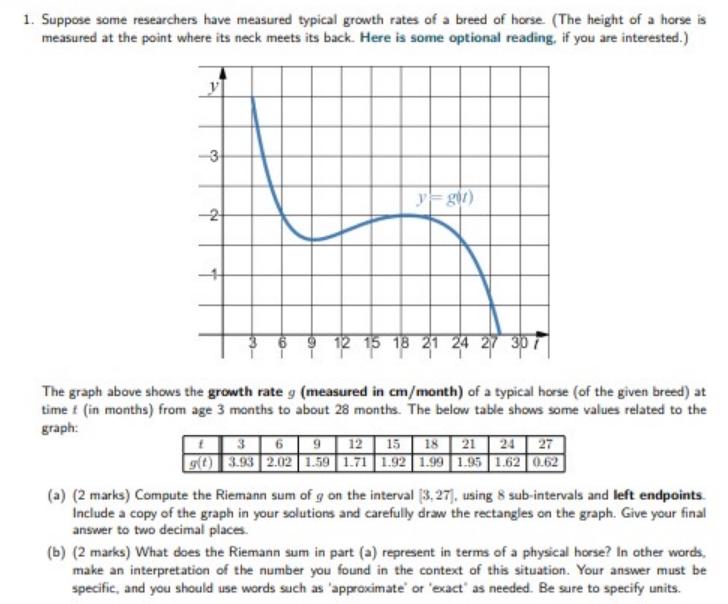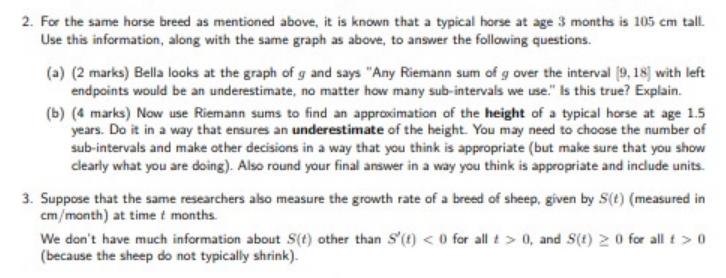Answered step by step
Verified Expert Solution
Question
1 Approved Answer
1. Suppose some researchers have measured typical growth rates of a breed of horse. (The height of a horse is measured at the point



1. Suppose some researchers have measured typical growth rates of a breed of horse. (The height of a horse is measured at the point where its neck meets its back. Here is some optional reading, if you are interested.) y=got) The graph above shows the growth rate g (measured in cm/month) of a typical horse (of the given breed) at time / (in months) from age 3 months to about 28 months. The below table shows some values related to the graph: 3 6 9 12 15 18 21 24 27 g(t) 3.93 2.02 1.59 1.71 1.92 1.99 1.95 1.62 0.62 (a) (2 marks) Compute the Riemann sum of g on the interval [3,27), using 8 sub-intervals and left endpoints Include a copy of the graph in your solutions and carefully draw the rectangles on the graph. Give your final answer to two decimal places. (b) (2 marks) What does the Riemann sum in part (a) represent in terms of a physical horse? In other words, make an interpretation of the number you found in the context of this situation. Your answer must be specific, and you should use words such as 'approximate' or 'exact as needed. Be sure to specify units. 2. For the same horse breed as mentioned above, it is known that a typical horse at age 3 months is 105 cm tall. Use this information, along with the same graph as above, to answer the following questions. (a) (2 marks) Bella looks at the graph of g and says "Any Riemann sum of g over the interval [9, 18] with left endpoints would be an underestimate, no matter how many sub-intervals we use." Is this true? Explain. (b) (4 marks) Now use Riemann sums to find an approximation of the height of a typical horse at age 1.5 years. Do it in a way that ensures an underestimate of the height. You may need to choose the number of sub-intervals and make other decisions in a way that you think is appropriate (but make sure that you show clearly what you are doing). Also round your final answer in a way you think is appropriate and include units. 3. Suppose that the same researchers also measure the growth rate of a breed of sheep, given by S(t) (measured in cm/month) at time t months. We don't have much information about S(t) other than S'(t) 0, and S(t) 20 for all f> 0 (because the sheep do not typically shrink). (a) (2 marks) Consider the following three quantities. Explain what each one represents. Be as specific as possible and specify units. (Note that you do not need to evaluate any of them.) A = S(t) dt S(t) dt C = S(t) dt (b) (3 marks) Is it possible to order A, B, C in terms of size, or is there not enough information? Order them from smallest to largest if possible, and regardless explain your reasoning. B = =
Step by Step Solution
There are 3 Steps involved in it
Step: 1

Get Instant Access to Expert-Tailored Solutions
See step-by-step solutions with expert insights and AI powered tools for academic success
Step: 2

Step: 3

Ace Your Homework with AI
Get the answers you need in no time with our AI-driven, step-by-step assistance
Get Started


